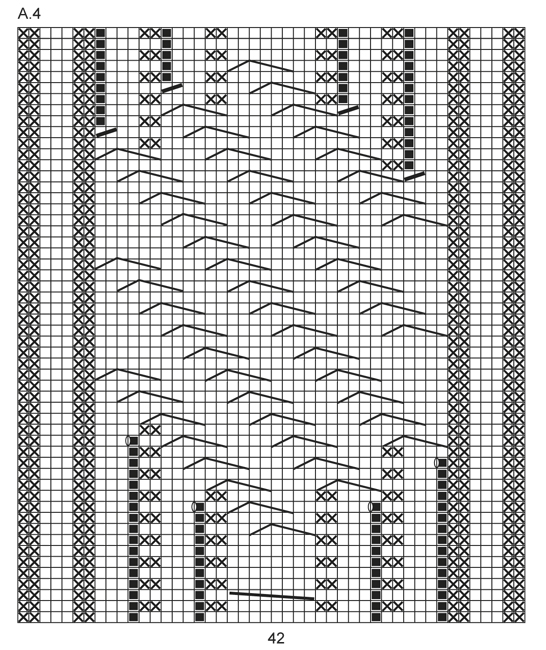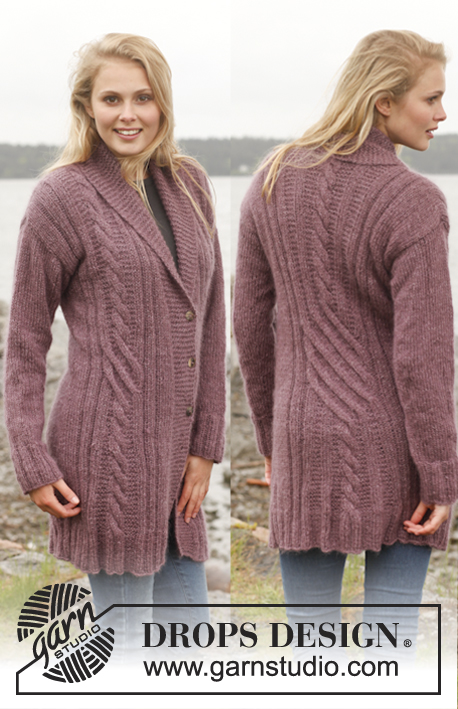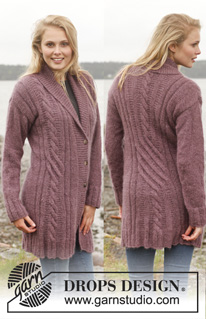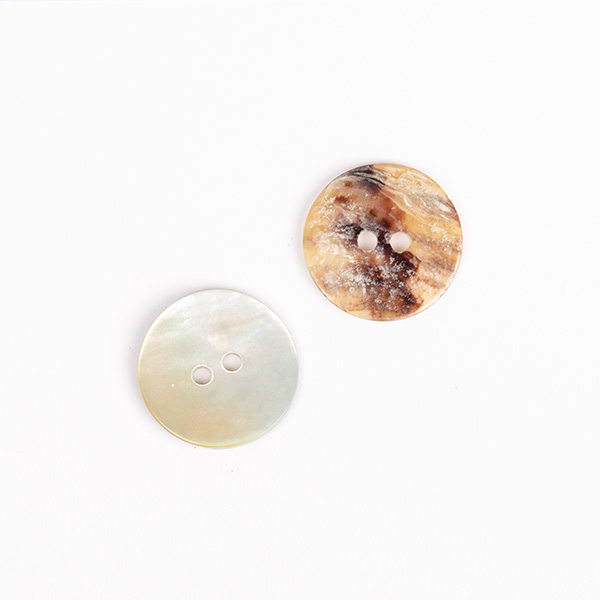Comments / Questions (71)
![]() Edith wrote:
Edith wrote:
Les explications ne correspondent pas au modele la bordure devant est faite en cotes et pas au point mousse
08.02.2023 - 21:23DROPS Design answered:
Bonjour Edith, dans ce modèle, on tricote bien les 12 mailles de bordure des devants au point mousse, et on va augmenter ce nombre de mailles point mousse pour former le col, et pour former le retombé du col châle, on tricote des rangs raccourcis sur les mailles du col (à la fin des devants). Bon tricot!
09.02.2023 - 10:25
![]() Xxx wrote:
Xxx wrote:
Les explications ne correspondent pas au modéle
08.02.2023 - 21:17
![]() Sophia wrote:
Sophia wrote:
In right front piece I don't understand this part: when piece measures 53 cm work 1st of front piece into band no of sts in garter ston band inc and no of sts in pattern on front piece dec (total no of sts is the same) repeat every cm . And then say when piece measures 56cm after all inc there are 66 sts on needle. I don't understand because I have 63 st on neendle and with all inc it will be more sts . In the pattern don't say anything about where I dec sts. Thank you.happy new year
02.01.2021 - 20:28DROPS Design answered:
Dear Sophia, in size L you have 61 sts on needle and increase a total of 6 sts (= 2 stitches 3 times in total in the garter stitch sections) = 67 sts, then you decrease 1 st on the side when piece meaesures 56 cm= 66 sts remain. At the same time, when piece measures 53 cm, increase the number of sts worked in garter stitch, work 1more sticth in garter stitch this means 1 stitch less in pattern(number of sts keeps constant). Hope it helps, happy knitting!
04.01.2021 - 15:56
![]() Renée Lamonde wrote:
Renée Lamonde wrote:
Bonjour, Je suis à faire le devant droit. Je ne comprend pas où faire les diminutions. Je n'arrive pas à faire coïncider les côtes et le motif comme le modèle. Merci!
15.02.2019 - 18:44DROPS Design answered:
Bonjour Mme Lamonde, pouvez-vous indiquer la taille que vous faites pour vérifier? Merci!
18.02.2019 - 08:32
![]() PLAUT wrote:
PLAUT wrote:
Bonjour, J'aimerais connaitre le nombre de pelotes à commander pour la taille L s'il vous plait ? Je ne trouve pas l'information. Merci
07.01.2019 - 05:14DROPS Design answered:
Bonjour Mme Plaut, vous trouverez la quantité totale requise pour chaque taille dans l'en-tête du modèle, soit en taille L: 400 g DROPS Alpaca/50 g la pelote = 8 pelotes DROPS Alpaca + 175 g DROPS Kid-Silk / 25 g la pelote = 7 pelotes DROPS Kid-Silk. Bon tricot!
07.01.2019 - 12:08
![]() Natasja De Jong wrote:
Natasja De Jong wrote:
Ik heb dit vest gebreid en ben er best lang bezig mee geweest. Het resultaat was schitterend. Echter na zo\'n 10x dragen beginnen onder de armen de draden nu al heel erg dun te worden. Dat vind ik wel heel erg zonde van al dat dure garen en het werk. Ik heb exact het garen uit het patroon gebruikt. Test u uw patronen niet op stevigheid? Dit heeft me behoorlijk wat geld gekost zo voor een vest wat ik nu slechts 10x gedragen heb! Kunt u mij tips geven?
20.12.2018 - 00:43DROPS Design answered:
Dag Natasja,
Alpaca is helaas iets kwetsbaarder dan gewone wol. Probeer het in ieder geval net te vaak te wassen (Je kunt het ook buiten hangen, om te luchten) en voorzichtig te wassen. Bij klachten over de wol, kun je het beste naar de winkel gaan waar je de wol hebt gekocht.
01.01.2019 - 20:49
![]() Gina Jarvis wrote:
Gina Jarvis wrote:
There is no size in inches or otherwise for me to decipher what size to make???
24.08.2017 - 18:32DROPS Design answered:
Dear Mrs Jarvis, all measurements in chart are in cm - convert into inches here. Happy knitting!
28.08.2017 - 13:04
![]() DÁNIEL REUSS wrote:
DÁNIEL REUSS wrote:
Nagyon tetszik nekem a kardigán. Hogyan tudnám megvenni , ha meg szeretném venni ?
18.07.2017 - 21:05DROPS Design answered:
Kedves Dániel, ezt a kardigánt készen nem tudja megvenni. Viszont az ingyenesen elérhető minta, leírás alapján a kardigán elkészíthető. Üdvözlettel.
23.07.2017 - 21:55
![]() Kirsten Asmussen wrote:
Kirsten Asmussen wrote:
Hej! Kan jeg strikke cardiganen med garn fra garngruppe C?
23.09.2016 - 14:37DROPS Design answered:
Hej Kirsten. Ja, du kan sagtens erstatte 2 traade fra gruppe A med 1 traad fra gruppe C. Husk at strikke en pröve saa du ved din strikkefasthed er i orden.
27.09.2016 - 16:13
![]() Lardiere wrote:
Lardiere wrote:
Je m étonné de la largeur des devants 80 mailles par rapport au dos 108 mailles n y ayrait il pas une erreur. Merci de votre rapide réponse por faire les devants
27.04.2015 - 18:15DROPS Design answered:
Bonjour Mme Lardiere, tout est bien correct, en taille XL, on monte bien 108 m pour le dos (= 94 m après les côtes, au 1er rang point fantaisie), et 80 m pour le devant (73 m après les côtes, au 1er rang point fantaisie, y compris les 12 m de bordure devant). Bon tricot!
28.04.2015 - 09:36
Twist#twistcardigan |
||||||||||||||||||||||||||||
 |
 |
|||||||||||||||||||||||||||
Knitted DROPS jacket with cables and shawl collar in "Alpaca" and "Kid-Silk". Size: S - XXXL.
DROPS 151-4 |
||||||||||||||||||||||||||||
|
GARTER ST (back and forth on needle): K all rows. 1 ridge = 2 rows K. PATTERN: See diagrams A.1 to A.5. The diagrams show all rows in pattern seen from RS. BUTTONHOLE: Dec for buttonholes on right band. 1 buttonhole = K tog third and fourth st from mid front and make 1 YO. Dec for buttonholes when piece measures: SIZE S: 33, 41 and 49 cm SIZE M: 35, 43 and 51 cm SIZE L: 37, 45 and 53 cm SIZE XL: 39, 47 and 55 cm SIZE XXL: 41, 49 and 57 cm SIZE XXXL: 43, 51 and 59 cm ---------------------------------------------------------- BACK PIECE: Worked back and forth on circular needle. Cast on 88-88-98-108-118-128 sts (incl 1 edge st in each side) on circular needle size 5 mm with 1 strand of each yarn. P 1 row from WS, then work as follows - from RS: 1 edge st (worked in garter st), P 1, * K 3, P 2 *, repeat from *-* 4-4-5-6-7-8 times in total, K 3, P 6, K 3, P 6, K 3, P 2, K 3, P 6, K 3, P 6, * K 3, P 2 *, repeat from *-* 4-4-5-6-7-8 times in total, finish with K 3, P 1 and 1 edge st (worked in garter st). Work rib like this for 8 cm. Switch to circular needle size 6 mm. Then work as follows seen from RS: 1 edge st, K 14-14-19-24-29-34 AT THE SAME TIME dec 3-0-2-3-3-3 sts evenly over these sts, P 2, K 3, P 2, K 3, 6 sts in garter st, K 3, 6 sts in garter st, A.1 (= 8 sts), 6 sts in garter st, K 3, 6 sts in garter st, K 3, P 2, K 3, P 2, K 14-14-19-24-29-34 AT THE SAME TIME dec 3-0-2-3-3-3 sts evenly over these sts, 1 edge st in garter st = 82-88-94-102-112-122 sts. REMEMBER THE KNITTING TENSION! Continue this pattern (11-14-17-21-26-31 in stocking st in each side), AT THE SAME TIME when piece measures 9 cm, dec 1 st in each of the 4 sections in garter st. Repeat dec every 3½ cm 3 more times (4 dec in total, 16 sts dec), dec alternately at beg and end of sections in garter st by K 2 tog = 66-72-78-86-96-106 sts. When piece measures approx. 20 cm - adjust so that one whole repetition has been worked of A.1 vertically and last dec is done - continue as follows – from RS: 1 edge st in garter st, K 11-14-17-21-26-31, A.4 (= 42 sts), K 11-14-17-21-26-31 and 1 edge st in garter st. Continue until A.4 has been work 1 time vertically. Now work as follows from RS: 1 edge st, K 11-14-17-21-26-31, P 2, K 3, P 2, K 3, 2 sts in garter st, K 3, 2 sts in garter st, A.1 (= 8 sts), 2 sts in garter st, K 3, 2 sts in garter st, K 3, P 2, K 3, P 2, K 11-14-17-21-26-31, 1 edge st in garter st. When piece measures 50 cm, inc 1 st in every section in garter st, repeat inc every 10-10-11-11-12-12 cm 2 more times (3 inc in total = 12 sts inc), inc alternately at beg and end of section in garter st. AT THE SAME TIME when piece measures 54-55-56-57-58-59 cm, dec 1 edge st in each side. Continue the pattern like this. After all inc are done there are 76-82-88-96-106-116 sts on needle. When piece measures 70-72-74-76-78-80 cm, cast off the middle 16-16-18-18-20-20 sts for neck and finish each shoulder separately. On next row from the neck, dec 1 st = 29-32-34-38-42-47 sts remain for shoulder. Cast off when piece measures 72-74-76-78-80-82 cm. RIGHT FRONT PIECE: Cast on 70-70-70-80-80-90 sts (incl 1 edge st in the side and 12 band sts towards mid front) on circular needle size 5 mm with 1 strand of each yarn. P 1 row from WS, then work as follows - from RS: 12 band sts (worked in garter st), * K 3, P 2 *, repeat from *-* 3-3-3-4-4-5 times in total, K 3, P 6, K 3, P 2, K 3, P 6, * K 3, P 2 *, repeat from *-* 3-3-3-4-4-5 times in total, finish with K 3, P 1 and 1 edge st (worked in garter st). Work rib for 8 cm, switch to circular needle size 6 mm, then work as follows from RS. 12 band sts (worked in garter st), K 8-8-8-13-13-18 AT THE SAME TIME dec 3-2-0-3-1-4 sts evenly over these sts, P 2, K 3, P 2, K 3, 6 sts in garter st, A.1 (= 8 sts), 6 sts in garter st, K 3, P 2, K 3, P 2, K 9-9-9-14-14-19 AT THE SAME TIME dec 4-3-1-4-2-5 sts evenly over these sts, 1 edge st in garter st = 63-65-69-73-77-81 sts. REMEMBER THE KNITTING TENSION! Continue this pattern (5-6-8-10-12-14 sts in stocking st in each side). AT THE SAME TIME when piece measures 9 cm, dec 1 st in each of the 2 sections in garter st. Repeat dec every 5½ cm 3 more times (4 dec in total, 8 sts dec), dec alternately at beg and end of sections in garter st = 55-57-61-65-69-73 sts. When piece measures approx. 26 cm - adjust so that one whole repetition has been worked of A.1 vertically - continue as follows – from RS: 12 band sts in garter st, K 5-6-8-10-12-14, A.3 (= 32 sts), K 5-6-8-10-12-14 and 1 edge st in garter st. Continue until A.3 has been work 1 time vertically. Now work as follows from RS: 12 sts in garter st (band), K 5-6-8-10-12-14, P 2, K 3, P 2, K 3, 2 sts in garter st, A.1 (= 8 sts), 2 sts in garter st, K 3, P 2, K 3, P 2, K 5-6-8-10-12-14, 1 edge st in garter st. Remember to dec for BUTTONHOLES - see explanation above. When piece measures 45 cm, inc 1 st in every section in garter st, repeat inc every 10-10-11-11-12-12 cm 2 more times (3 inc in total = 6 sts inc), inc alternately at beg and end of section in garter st. AT THE SAME TIME when piece measures 49-51-53-55-57-59 cm, work 1 st of front piece into band, i.e. no of sts in garter st on band inc and no of sts in pattern on front piece dec (total no of sts is the same), repeat every cm 19-18-20-20-20-19 times in total (= 31-30-32-32-32-31 sts in garter st on band). AT THE SAME TIME when piece measures 54-55-56-57-58-59 cm, dec 1 edge st in the side. Continue the pattern like this. After all inc are done there are 60-62-66-70-74-78 sts on needle. When piece measures 72-74-76-78-80-82 cm, cast off the first 29-32-34-38-42-47 sts from WS for shoulder = 31-30-32-32-32-31 sts remain on needle. Work the rest of row. Then work short rows over the 31-30-32-32-32-31 sts as follows - from RS: * Work 2 rows over the first 15 sts, work 2 rows over all sts *, repeat from *-* until neck edge measures 8-8-9-9-10-10 cm at the shortest. Cast off. LEFT FRONT PIECE: Cast on and work the same way as on right front piece but reversed - work A.2 instead of A.1 and A.5 instead of A.3. Beg as follows: P 1 row from WS, then work as follows - from RS: 1 edge st (worked in garter st) P 1, K 3, * P 2, K 3 *, repeat from *-* 3-3-3-4-4-5 times in total, P 6, K 3, P 2, K 3, P 6, K 3, * P 2, K 3 *, repeat from *-* 3-3-3-4-4-5 times in total, 12 band sts (worked in garter st). Do not dec for buttonholes. SLEEVE: Worked in the round on double pointed needles. Cast on 45-45-50-50-55-55 sts on double pointed needles size 5 mm with 1 strand of each yarn. Work rib = K 3/P 2. When piece measures 7 cm, switch to double pointed needles size 6 mm. Continue in stocking st AT THE SAME TIME on 1st round dec 7-7-10-8-11-9 sts evenly = 38-38-40-42-44-46 sts. Insert 1 marker at the beg of round. Work in stocking st, AT THE SAME TIME inc 1 st on each side of marker, repeat inc every 4-3½-3½-3-2½-2½ cm 9-10-11-12-12-13 more times (10-11-12-13-13-14 inc in total) = 58-60-64-68-70-74 sts. When piece measures 50-50-49-47-45-43 cm (shorter measurements in the larger sizes because of wider shoulders), cast off all sts. Knit another sleeve. ASSEMBLY: Sew the shoulder seams. Sew the side seams inside 1 edge st. Sew in sleeves. Sew the collar tog mid back and sew it to the neckline. Sew the buttons on to left front piece. |
||||||||||||||||||||||||||||
Diagram explanations |
||||||||||||||||||||||||||||
|
||||||||||||||||||||||||||||

|
||||||||||||||||||||||||||||

|
||||||||||||||||||||||||||||

|
||||||||||||||||||||||||||||

|
||||||||||||||||||||||||||||
Have you finished this pattern?Tag your pictures with #dropspattern #twistcardigan or submit them to the #dropsfan gallery. Do you need help with this pattern?You'll find 23 tutorial videos, a Comments/Questions area and more by visiting the pattern on garnstudio.com. © 1982-2025 DROPS Design A/S. We reserve all rights. This document, including all its sub-sections, has copyrights. Read more about what you can do with our patterns at the bottom of each pattern on our site. |
||||||||||||||||||||||||||||












































































Post a comment to pattern DROPS 151-4
We would love to hear what you have to say about this pattern!
If you want to leave a question, please make sure you select the correct category in the form below, to speed up the answering process. Required fields are marked *.